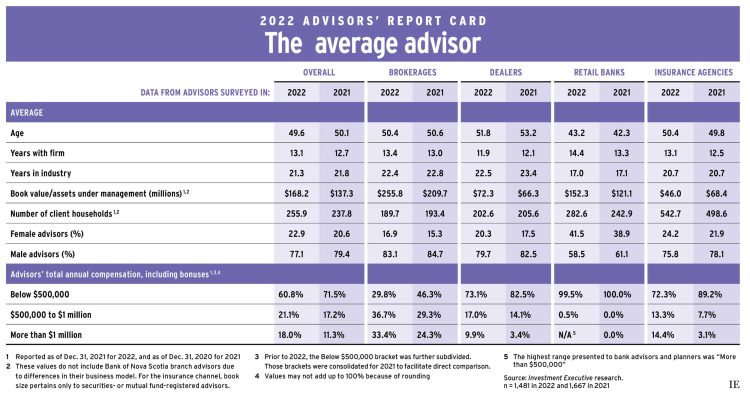
This article appears in the Mid-October 2022 issue of Investment Executive. Subscribe to the print edition, read the digital edition or read the articles online.
Financial advisors have seen their assets under management (AUM) and compensation improve, according to the 2022 Advisors’ Report Card, which aggregates the findings from Investment Executive’s 2022 brokerage, dealers, retail bank and insurance Report Cards.
The average book size across the four industry segments, reported as of Dec. 31, 2021, rose by 22.5% to $168.2 million in AUM from $137.3 million last year. Although average AUM dropped in the insurance segment year over year, many of those advisors don’t have significant investment books. The brokerage, dealers and retail bank segments, however, all saw increases in average book size.
Much of that AUM growth can likely be attributed to market gains. For example, the S&P/TSX composite index returned 25.1% in 2021. And those gains came against the backdrop of record-low interest rates, rising incomes and savings, and pandemic-driven government supports. Many of those trends have since reversed.
Rising AUM wasn’t the only notable trend in this year’s Advisors’ Report Card. The average number of client households served increased to 255.9 from 237.8.
However, while client households rose notably for retail bank and insurance advisors (see chart), brokerage and dealer advisors reported serving fewer households. This meant that brokerage and dealer advisors also enhanced their productivity (measured as AUM per client household) year over year.
As rising markets boosted AUM, advisors may have used the opportunity to trim client rosters and devote more attention to their higher-net-worth accounts. Indeed, in both the brokerage and dealer segments, the percentage of clients with more than $1 million in AUM increased between the 2021 and 2022 Report Cards. But, to the extent that AUM will contract alongside markets in the year ahead, client numbers may be affected if advisors return to adding clients as a way to drive growth.
Nonetheless, the industry overall enjoyed the spoils of growth over the past year, as reflected in the reported levels of advisor compensation. Combined, more than one-third of advisors across the industry reported making at least $500,000 per year in the 2022 research.
Across all Report Cards, the proportion of advisors who reported making under $500,000 declined to 60.8% (as of Dec. 31, 2021), from 71.5% (as of Dec. 31, 2020), while the share of advisors at the top of the pay distribution scale grew over the same period.
In particular, the proportion of advisors who reported earning more than $1 million per year jumped to 18.0% in this year’s results, from 11.3% last year. (The retail bank channel is excluded from this group as the highest pay range presented to them is “more than $500,000.”)
Additionally, 21.1% of the advisors surveyed in the 2022 research reported making between $500,000 and $1 million, up from 17.2% in the 2021 research.
The industry also reported shifts in its underlying demographics. For example, the average advisor in this year’s Advisors’ Report Card is slightly younger than last year’s average: 49.6, compared with 50.1 in 2021.
That decline was also matched by a slight dip in average industry experience, to 21.3 years in 2022 from 21.8 last year.
These trends were strongest in the dealer segment, and occurred to a lesser extent among the brokerage segment. Retail bank advisors and insurance advisors, however, reported a slight increase in their average ages, and their average industry tenures were essentially unchanged.
But an advisor’s average tenure with their firm rose to 13.1 years in 2022, from 12.7 years in 2021, suggesting that most advisors stayed put while business was good.
Whether the current market volatility affects advisors’ books and compensation, the growth generated in the wake of the initial pandemic shock will, hopefully, provide a buffer during the uncertainty.
Click image for full-size chart
